76
[latexpage]
Learning Objectives
- Describe the use of heat engines in heat pumps and refrigerators.
- Demonstrate how a heat pump works to warm an interior space.
- Explain the differences between heat pumps and refrigerators.
- Calculate a heat pump’s coefficient of performance.
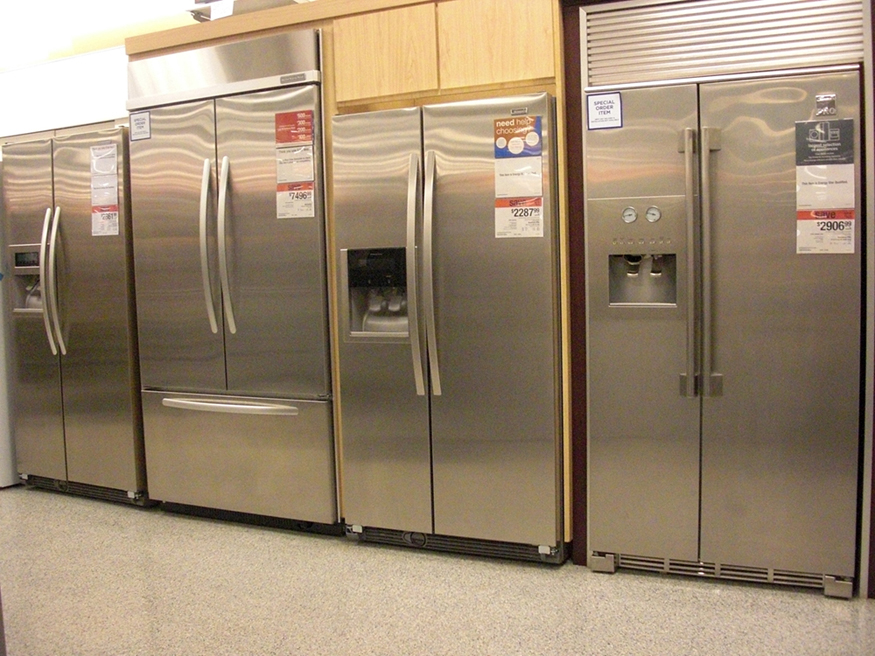
Heat pumps, air conditioners, and refrigerators utilize heat transfer from cold to hot. They are heat engines run backward. We say backward, rather than reverse, because except for Carnot engines, all heat engines, though they can be run backward, cannot truly be reversed. Heat transfer occurs from a cold reservoir

Heat Pumps
The great advantage of using a heat pump to keep your home warm, rather than just burning fuel, is that a heat pump supplies
The basic components of a heat pump in its heating mode are shown in (Figure). A working fluid such as a non-CFC refrigerant is used. In the outdoor coils (the evaporator), heat transfer
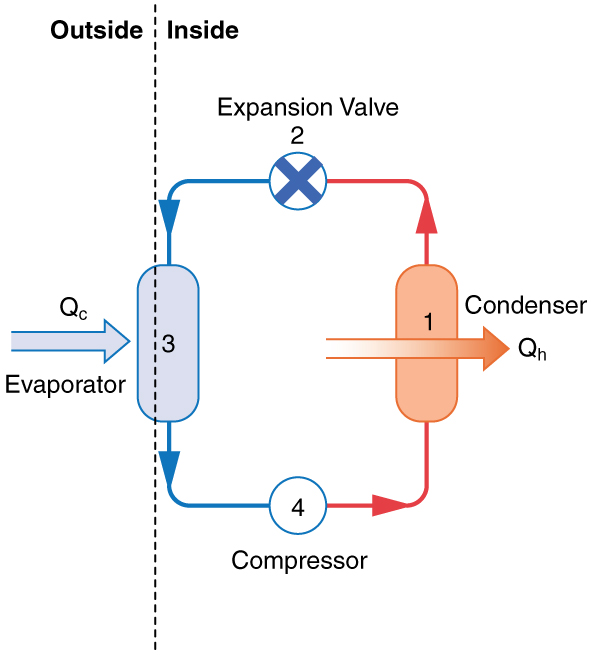
The electrically driven compressor (work input
The quality of a heat pump is judged by how much heat transfer
Since the efficiency of a heat engine is
Friction and other irreversible processes reduce heat engine efficiency, but they do not benefit the operation of a heat pump—instead, they reduce the work input by converting part of it to heat transfer back into the cold reservoir before it gets into the heat pump.
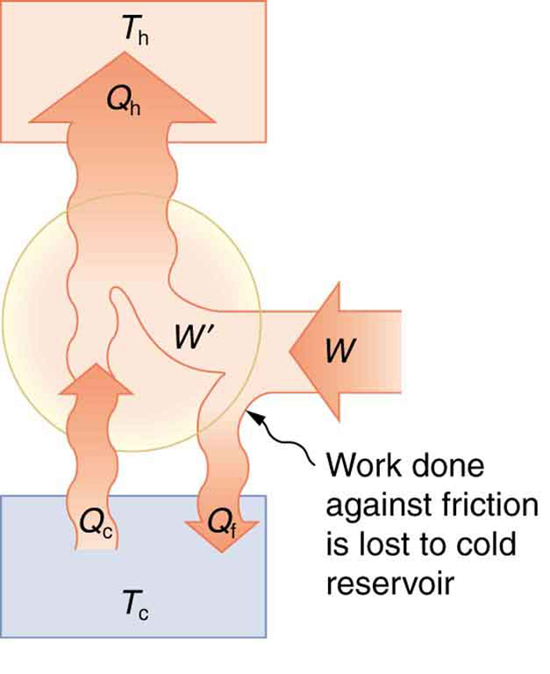
A heat pump used to warm a home must employ a cycle that produces a working fluid at temperatures greater than typical indoor temperature so that heat transfer to the inside can take place. Similarly, it must produce a working fluid at temperatures that are colder than the outdoor temperature so that heat transfer occurs from outside. Its hot and cold reservoir temperatures therefore cannot be too close, placing a limit on its
Strategy
A Carnot engine reversed will give the best possible performance as a heat pump. As noted above,
Solution
Carnot efficiency in terms of absolute temperature is given by:
The temperatures in kelvins are
Thus, from the discussion above,
or
so that
Discussion
This result means that the heat transfer by the heat pump is 5.30 times as much as the work put into it. It would cost 5.30 times as much for the same heat transfer by an electric room heater as it does for that produced by this heat pump. This is not a violation of conservation of energy. Cold ambient air provides 4.3 J per 1 J of work from the electrical outlet.
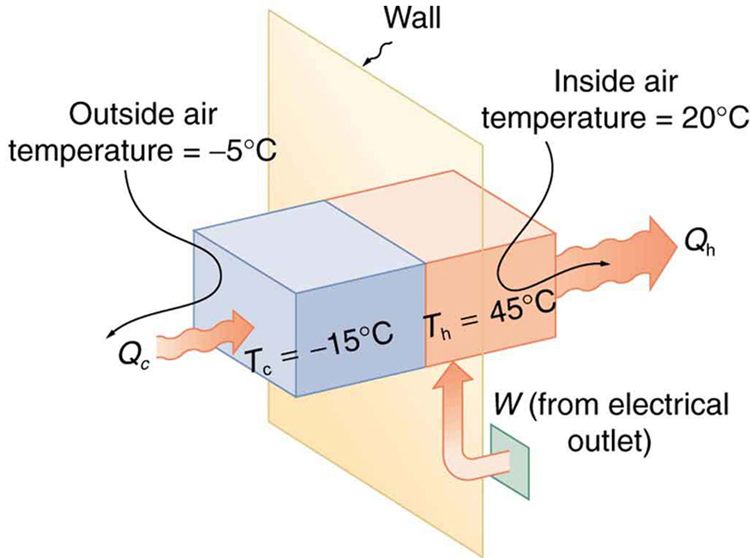
Real heat pumps do not perform quite as well as the ideal one in the previous example; their values of
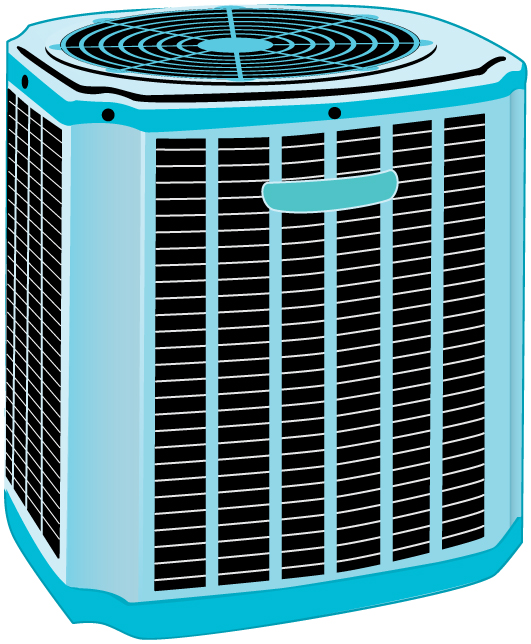
Air Conditioners and Refrigerators
Air conditioners and refrigerators are designed to cool something down in a warm environment. As with heat pumps, work input is required for heat transfer from cold to hot, and this is expensive. The quality of air conditioners and refrigerators is judged by how much heat transfer
Noting again that
for a heat engine used as either an air conditioner or a heat pump operating between the same two temperatures. Real air conditioners and refrigerators typically do remarkably well, having values of
A type of
The
where
- Examine the situation to determine whether heat, work, or internal energy are involved. Look for any system where the primary methods of transferring energy are heat and work. Heat engines, heat pumps, refrigerators, and air conditioners are examples of such systems.
- Identify the system of interest and draw a labeled diagram of the system showing energy flow.
- Identify exactly what needs to be determined in the problem (identify the unknowns). A written list is useful. Maximum efficiency means a Carnot engine is involved. Efficiency is not the same as the coefficient of performance.
- Make a list of what is given or can be inferred from the problem as stated (identify the knowns). Be sure to distinguish heat transfer into a system from heat transfer out of the system, as well as work input from work output. In many situations, it is useful to determine the type of process, such as isothermal or adiabatic.
- Solve the appropriate equation for the quantity to be determined (the unknown).
- Substitute the known quantities along with their units into the appropriate equation and obtain numerical solutions complete with units.
- Check the answer to see if it is reasonable: Does it make sense? For example, efficiency is always less than 1, whereas coefficients of performance are greater than 1.
Section Summary
- An artifact of the second law of thermodynamics is the ability to heat an interior space using a heat pump. Heat pumps compress cold ambient air and, in so doing, heat it to room temperature without violation of conservation principles.
- To calculate the heat pump’s coefficient of performance, use the equation
- A refrigerator is a heat pump; it takes warm ambient air and expands it to chill it.
Conceptual Questions
Explain why heat pumps do not work as well in very cold climates as they do in milder ones. Is the same true of refrigerators?
In some Northern European nations, homes are being built without heating systems of any type. They are very well insulated and are kept warm by the body heat of the residents. However, when the residents are not at home, it is still warm in these houses. What is a possible explanation?
Why do refrigerators, air conditioners, and heat pumps operate most cost-effectively for cycles with a small difference between
Grocery store managers contend that there is less total energy consumption in the summer if the store is kept at a low temperature. Make arguments to support or refute this claim, taking into account that there are numerous refrigerators and freezers in the store.
Can you cool a kitchen by leaving the refrigerator door open?
Problem Exercises
What is the coefficient of performance of an ideal heat pump that has heat transfer from a cold temperature of
4.82
Suppose you have an ideal refrigerator that cools an environment at
What is the best coefficient of performance possible for a hypothetical refrigerator that could make liquid nitrogen at
0.311
In a very mild winter climate, a heat pump has heat transfer from an environment at
(a) What is the best coefficient of performance for a heat pump that has a hot reservoir temperature of
(a) 4.61
(b)
(c) To transfer 

(a) What is the best coefficient of performance for a refrigerator that cools an environment at
Suppose you want to operate an ideal refrigerator with a cold temperature of
An ideal heat pump is being considered for use in heating an environment with a temperature of
A 4-ton air conditioner removes
(a)
(b) 40 cents
(c) This cost seems quite realistic; it says that running an air conditioner all day would cost 
Show that the coefficients of performance of refrigerators and heat pumps are related by
Start with the definitions of the
Glossary
- heat pump
- a machine that generates heat transfer from cold to hot
- coefficient of performance
- for a heat pump, it is the ratio of heat transfer at the output (the hot reservoir) to the work supplied; for a refrigerator or air conditioner, it is the ratio of heat transfer from the cold reservoir to the work supplied

